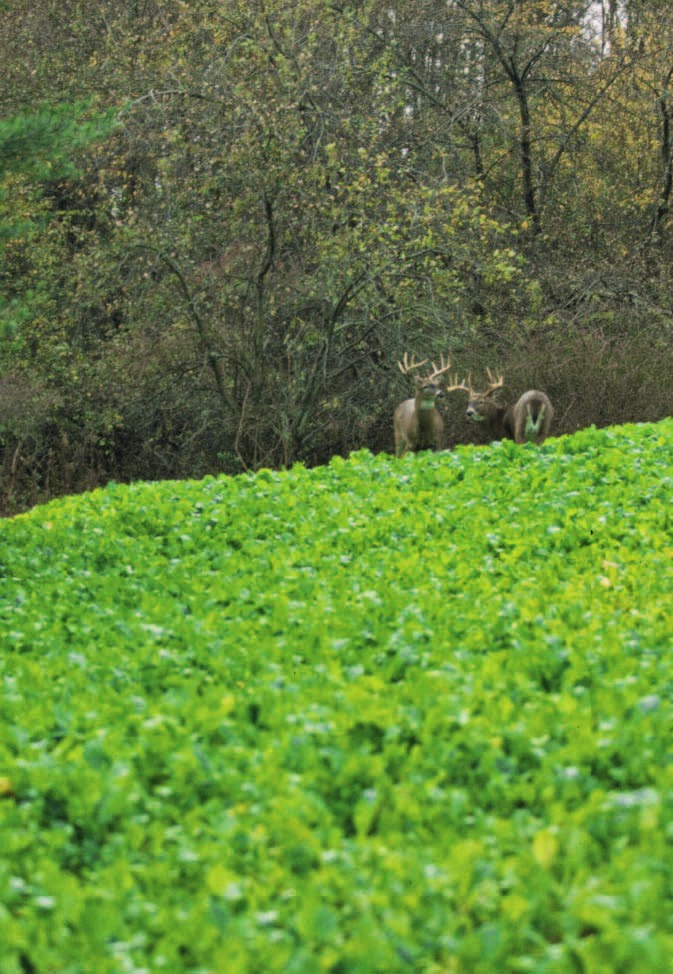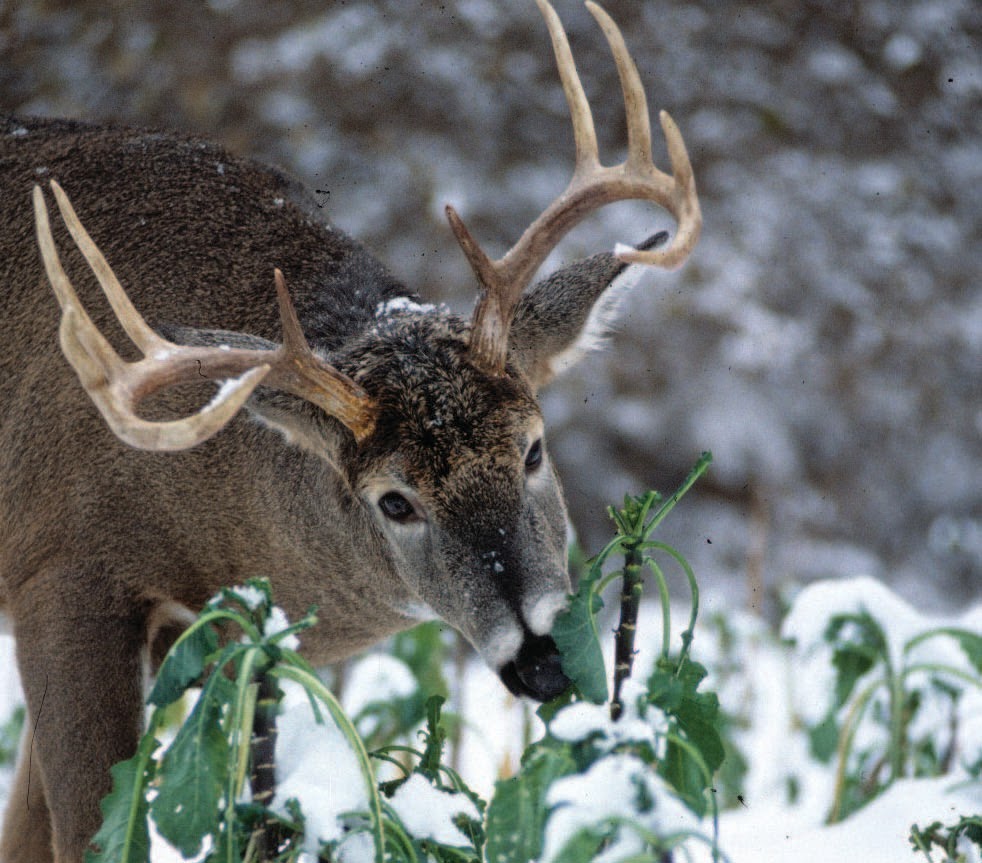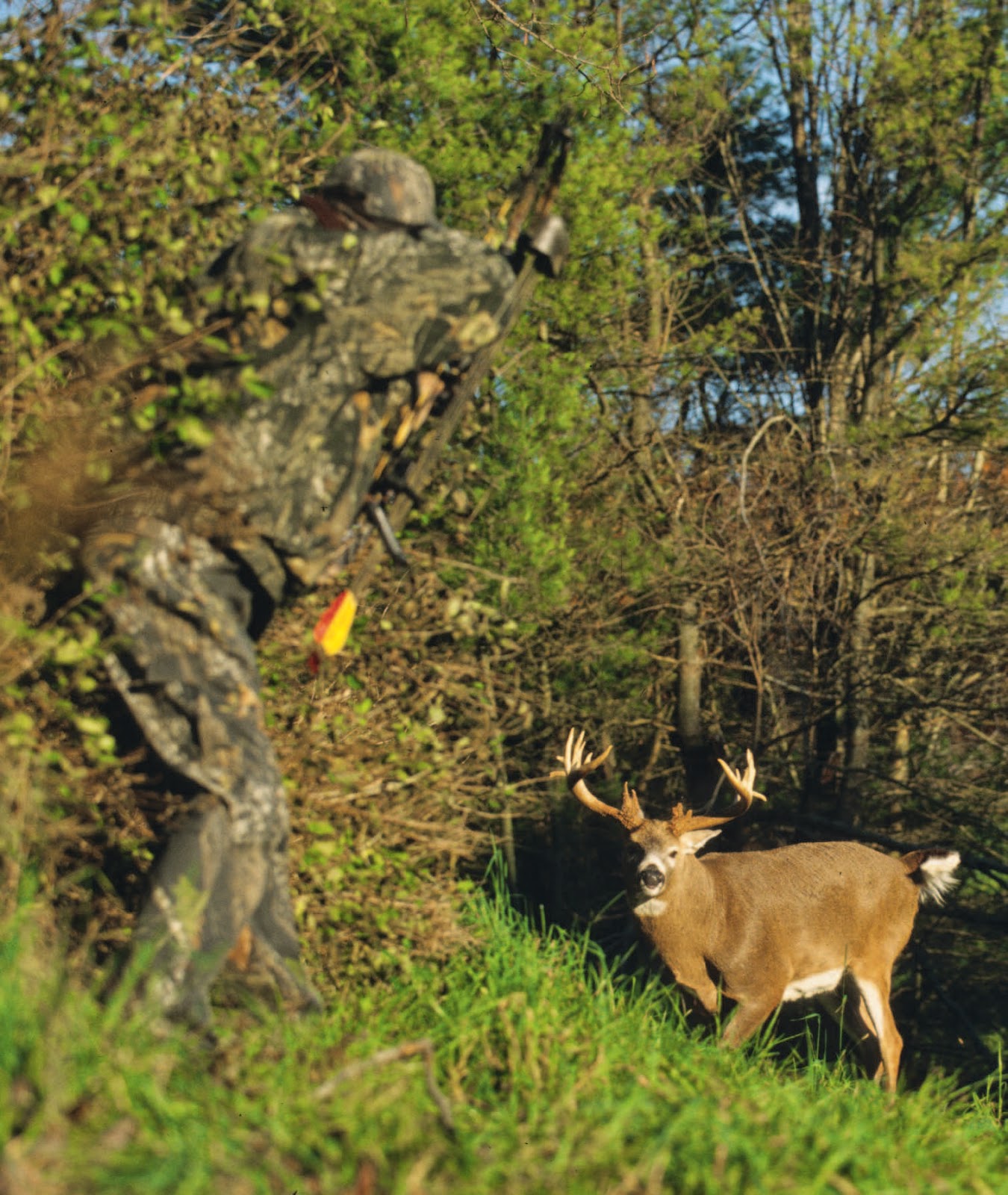YOUR CHOICE: PLANT TO FEED OR PLANT TO KILL
BY Charles J Alsheimer
The Bible says in Galatians 6:7, “Whatever a man sows, this he will also reap.” I often find myself thinking of this verse when analyzing all that goes into the process of feeding, holding, raising and managing whitetails.
When I started raising whitetail deer nearly two decades ago, I was struck by how much food each deer consumed. I knew they were hearty eaters, but I never realized that when deer were on their feet, they were looking for something to eat. Though each deer’s appetite is slightly different, they each consume 1½ or more tons of food per year. Because of this, it's imperative that lots of natural and grown food is available if you want to hold deer on your property.
Plant to Feed
 To feed deer properly, think in terms of the tonnage required, the soil’s ability to grow the plants, what seeds will grow best on your land, and how a food plot is angled to the sun so the seeds can grow to their full potential.
To feed deer properly, think in terms of the tonnage required, the soil’s ability to grow the plants, what seeds will grow best on your land, and how a food plot is angled to the sun so the seeds can grow to their full potential.
Tonnage: You must carefully analyze a property’s deer population and habitat type to know how much food must be produced. In most cases, you’ll be able to figure out if you have too many deer by examining the natural habitat. If there is little natural growth from the ground to 5 feet off the ground, you need to kill more deer or provide more grown food — probably both — because natural habitat will not sustain the deer on the property. Even the best natural habitat will have a difficult time producing more than a ton of food per acre on a yearly basis. In truth, in many portions of the country, the natural habitat produces less than 500 pounds per acre annually. So, food plots are the only way to get the tonnage of food needed to feed a wild deer population. To hold deer on a property, adequate food must be available throughout the year, not just during hunting season. In my region of the Northeast, that means that from mid-May through January, I must have grown food available if I have any hope of holding deer on our farm. To accomplish this requires a well-thought-out plan. When it comes to feeding deer, the plot size matters a lot. Therefore, I lay out our feeding and hunting plots differently. Our feeding plots are large and not necessarily laid out with hunting in mind. Hunting plots, which I’ll discuss later, are smaller.
Soil: No properties have the same soil quality. In poor soils (where soil pH struggles to get higher than 6.0) it will be difficult to grow more than 3 to 4 tons of forage per acre. If a food plot’s soil is 6.5 or better, you might be able to grow forages that provide in excess of 8 tons per acre. If your soil is not at least 6.0, work diligently through liming practices to get a pH of 6.5. Doing so will let plants grow to their potential. Knowing a property’s deer population and soil type will go a long way toward determining how much food is needed.
Seed selection: With all the media hype, it can be difficult to know which forage provides the biggest bang for your buck while giving the deer the nutrition they require. As I have written in the past, the whitetails I’ve raised at my research facility have taught me a lot about what they prefer for forage offerings. Simply, 14 years of analysis have shown me that few forage offerings can rival Imperial Whitetail Clover. When it comes to whitetail food offerings, variety is the spice of life. Forage variety also offers the various nutrients deer require. Therefore, I plant Imperial Whitetail Extreme and Imperial Whitetail Fusion blends to make sure that all of our whitetail’s nutritional requirements are met. In addition to the nutrients they offer, Extreme and Fusion are drought resistant, which provides a bit of insurance should July or August be unseasonably dry. I rely on Winter-Greens (brassicas), Pure Attraction (winter-hardy oats and brassicas), and Imperial Beets and Greens (Blend of brassicas, Sugar Beets, Deer Radish and turnips) to provide the tonnage needed to feed and hold deer on our farm from October to January.
For some of our smaller hunting plots, I’ve had great success with Secret Spot, which contains cereal grains, brassica and clover. And don’t skimp on fertilizer. To bump up the tonnage and create healthier plants, I fertilize our Imperial Clover, Fusion and Extreme plots in May and late August at a rate of 400 pounds per acre.
Size, light and location: To grow the tonnage of food your deer need will probably require more food plot acreage than you think. In most cases, at least 5 percent of a property should be planted in food plots. Prime feeding food plots need to receive at least five hours of sunlight each day. Their orientation to the sun is also critical. If a food plot is angled toward the sun, the ground temperature during the summer months has a tendency to overheat the ground, which bakes the plants and retards their growth. So, think of this when selecting a site for a feeding food plot. Also, place the feeding food plot as close to the prime bedding area as possible so deer don’t have to travel far to get to the plot. Strive to keep any food plot away from roadways and neighboring properties. Keeping prime food plots out of sight will ensure your property’s deer will not be viewed by every Tom, Dick and Harry. The last thing you want to do is raise deer and then have others kill them — namely poachers and surrounding landowners who might not share your management goals.
Plant to Kill
Initially, most food plot practitioners put little thought into whether their food plots can be effectively hunted. They just assume the food plot they’ve created will be an automatic honey hole come hunting season. In most cases, big squares will not provide desired hunting results. This is especially the case during archery season. To ensure great hunting opportunities, you must address four factors: forage offerings, being able to beat the wind, getting the deer close and stealth tactics.
 Time the offerings: The forage that works during summer might not be the right choice when October, November and December roll around. I continually share with my seminar audiences that a whitetail’s seasonal food preferences need to be addressed for hunting success. In my part of the country, Imperial Whitetail Clover is king during spring, summer, and fall. To keep our deer from gravitating to surrounding properties, in winter I select forages that will keep them around during hunting season. Pure Attraction and Winter-Greens are just the ticket to accomplish this. These blends are just coming into their own colder temperatures and snow arrive.
Time the offerings: The forage that works during summer might not be the right choice when October, November and December roll around. I continually share with my seminar audiences that a whitetail’s seasonal food preferences need to be addressed for hunting success. In my part of the country, Imperial Whitetail Clover is king during spring, summer, and fall. To keep our deer from gravitating to surrounding properties, in winter I select forages that will keep them around during hunting season. Pure Attraction and Winter-Greens are just the ticket to accomplish this. These blends are just coming into their own colder temperatures and snow arrive.
Air currents: In spite of what the scent-eliminating folks say, you can’t push the envelope when it comes to beating a whitetail’s nose — at least not 100 percent of the time. Never assume that air around a food plot will flow the same in summer as it does in October, November or December, because it doesn’t. Whenever you are on stand, take time to throw out floaters to see how they drift. You just may be surprised by what you see. And be sure to jot your findings down so that you’ll have a base point to go by in the future. The bottom line is that if you want to consistently kill bucks around food plots, you must know the ebb and flow of wind currents around each food plot you intend to hunt.

Funnel ’em in: When it comes to hunting a food plot, think small, irregular and secluded. For the most part, the bigger
feeding food plots will be used by deer at night. Few of these will be great hunting plots — at least not during archery season, because you never know where deer will enter the plot. To get deer to use food plots during daylight, they must feel secure. Lush food plots smaller than a half-acre, irregular in shape and surrounded by thick cover will be excellent deer magnets during hunting hours. It has been my experience that hourglass - and L-shaped hunting plots (laid out with air currents in mind) provide the best hunting opportunities. An hourglass plot causes deer to move through the tight neck of the hour glass, offering a great bow-stand set up. L-shaped plots are also great hunting setups because deer will move throughout the plot when they feed. One way to get a buck to go to a specific location on these hunting plots is to hang a mock licking branch in the plot near your stand location. Most deer using the plot will eventually work the branch before leaving the plot. The mock licking branch should be from preferred browse specie. It should also be hung so that the bottom tip of the branch is about 5 to 5 ½ feet off the ground.
Stealth entry/exit: After the proper stand location is determined, you must enact a strategy that allows for silent entry and exit. I make sure that my entry and exit can be done so that no deer know I’m around. A big part of this is accomplished by raking a narrow trail the last 100 yards to the stand. With the trail free of debris, I’m able to sneak to my stand without making a sound. Through the years, I’ve found that the best time to hunt near a food plot is the last three hours of the day. If the location isn’t exit friendly (because deer are always in the plot when nightfall comes), have someone pick you up with an ATV or vehicle. By letting the machine move the deer off the plot rather than you climbing from the tree, you will be less likely to make deer nocturnal.
Through the years, I’ve found that the best time to hunt near a food plot is the last three hours of the day. If the location isn’t exit friendly (because deer are always in the plot when nightfall comes), have someone pick you up with an ATV or vehicle. By letting the machine move the deer off the plot rather than you climbing from the tree, you will be less likely to make deer nocturnal.
